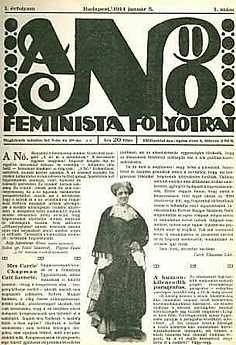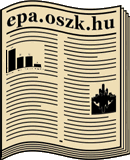The Woman. Feminist Journal. Correspondence, Editorial Strategies and Networks of Subscribers (1914–1927)
DOI:
https://doi.org/10.15170/PAAA.2020.07.02.01Keywords:
women's history, history of journalism, Association of Feminists, A Nő (journal), Vilma Glücklich, Rózsa Schwimmer, Adél SpádyAbstract
The Association of Feminists (founded in 1904 in Budapest by Vilma Glücklich and Rózsa Schwimmer) was one of the social organizations being active in the flourishing civil life of the turn of the century in the Austro–Hungarian Monarchy. The organizations played an active life in the reform processes and in the articulation of the interests of different social groups.
Schwimmer Rózsa proposed to launch a feminist periodical as the journal of their own movement. Woman and Society came out in 1907 as the bulletin of two organizations, the Association of Feminists and the National Association of Women Clerks. The editors were conscious of the importance of spreading the ideas of the movement and reaching a wider circle of supporters. As a social movement periodical The Woman and Society served its function to create an alternative public space for feminist ideas. The editors of the Hungarian feminist journal were in connection with the editorial board of the Jus Suffragii and exchanged the news of the international women’s movements.
The periodical of the Feminist Association in Budapest changed its title in 1914 to The Woman. Feminist Journal. It appeared as a fortnightly with a different layout, including more illustrations and also black and white photographs. The journal since then gained an increasing interest and became spread to many different parts of the country. It also had subscribers abroad.
The recent study examines the network of subscribers on the base of the archival source of the letters to the editors. The correspondence is also suitable for the examination of the editors’ strategies to disseminate the journal and reaching an even wider public of readers for their case of women’s emancipation.
Photo: National Széchényi Library
Downloads
References
Acsády Judit: A magyarországi feminizmus a századelőn. In: Politika, gazdaság és társadalom a XX. századi magyar történelemben. Szerk. Püski Levente – Tímár Lajos – Valuch Tibor. Debrecen, 1999. 295–309.
Acsády, Judit: “In a Different Voice”: Responses of Hungarian Feminism to the First World War. In: The Women’s Movement Wartime. International Perspective, 1914–1919. Eds. Fell, Alison S. – Sharp, Ingrid. London, 2007. 105–123. ǁ [DOI] https://doi.org/10.1057/9780230210790_7 ǁ [WoS] https://www.webofscience.com/wos/woscc/full-record/WOS:000282233000007
Acsády, Judit: Diverse Constructions: Feminist and Conservative Women’s Movements and their Contribution to the Reconstruction of Gender Relations in Hungary after the First World War. In: Aftermaths of War. Women’s Movements and Female Activists, 1918–1923. Eds. Sharp, Ingrid – Stibbe, Matthew. Leiden, 2011. 309–333. ǁ [DOI] https://doi.org/10.1163/ej.9789004191723.i-432.92
Acsády Judit: „Beszéljen a szívünk”. Háborúellenes hangok a hazai és nemzetközi nőmozgalomban az I. világháború idején. Társadalmi Nemek Tudománya Interdiszciplináris eFolyóirat 5. (2015):2. 1–20. (http://tntefjournal.hu/vol5/iss2/acsady.pdf) [2020.09.22.]
Acsády Judit – Mészáros Zsolt: Feminizmus a fővárosban és vidéken a múlt századelőn. In: Vidéki élet és vidéki társadalom Magyarországon. Szerk. Pap József – Tóth Árpád. Budapest, 2016. 486–502. (Rendi társadalom – polgári társadalom 28.)
Acsády Judit – Mészáros Zsolt: A Balmazújvárosi Szabad Nőszervezet és a Feministák Egyesülete közötti kapcsolat (1908–1929). A női szolidaritás megnyilvánulásai a hazai feminista mozgalomban. Társadalmi Nemek Tudománya Interdiszciplináris eFolyóirat 8.(2018):2. 80–96. (http://tntefjournal.hu/vol8/iss2/acsady_meszaros.pdf) [2020.09.22.]
Baldassari, Delia – Diani, Mario: The Integrative Power of Civic Networks. American Journal of Sociology 113. (2007):3. 735–780. ǁ [DOI] https://doi.org/10.1086/521839 ǁ [WoS] https://www.webofscience.com/wos/woscc/full-record/WOS:000251447000004
Balogh János Mátyás: Üzleti szellemű fővárosi napisajtó a dualizmus korában. A budapesti sajtóipar születése. Doktori disszertáció. Budapest, 2014.
Bódy Zsombor: Egy társadalmi osztály születése. A magántisztviselők társadalomtörténete 1890–1938. Budapest, 2003.
Politics and Friendship. Letters from the International Woman Suffrage Alliance, 1902–1942. Eds. Bosch, Mineke – Kloosterman, Annemarie. Columbus, 1990.
Buzinkay Géza: Kis magyar sajtótörténet. Budapest, 1993.
Czeferner Dóra: Az osztrák-magyar nőmozgalom nemzeti és transznacionális jellege. In: Mesterek és tanítványok. Tanulmányok a bölcsészettudományok területéről. Szerk. Böhm Gábor – Fedeles Tamás. Pécs, 2014. 154–168.
Czeferner Dóra: A magyarországi feminista mozgalom első hivatalos lapja: A Nő és a Társadalom (1907–1913). ArchívNET 19. (2019):2. (http://www.archivnet.hu/a-magyarorsza-gi-feminista-mozgalom-elso-hivatalos-lapja-a-no-es-a-tarsada-lom-1907-1913) [2019. 04. 07.]
DiCenzo, Maria – Acsády, Judit – David, Hudson – Sipos, Balázs: Mediating the National and the International: Women, Journalism and Hungary in the Aftermath of the First World War. In: Women Activists Between War and Peace Europe. 1918–1923. Eds. Sharp, Ingrid – Stibbe, Matthew. London, 2017. 173–219. ǁ [DOI] https://doi.org/10.5040/9781474205894.0012 ǁ [WoS] https://www.webofscience.com/wos/woscc/full-record/WOS:000452986100005
Elekes Irén Borbála: A századforduló feminista folyóirata. A Nő és a Társadalom (1907–1913). Könyv, könyvtár, könyvtáros 11. (2002):9. 40–48.
Fraser, Nancy: Rethinking the Public Sphere: A Contribution to the Critiques of Actually Existing Democracy. Social Text (1990):25–26. 56–80. ǁ [DOI] https://doi.org/10.2307/466240
Gyáni Gábor: Sajtótörténet a társadalomtörténet szempontjából. Médiakutató 7.(2006):1. 57–64.
Gyáni Gábor – Kövér György: Magyarország társadalomtörténete a reformkortól a második világháborúig. Budapest, 1998.
Nők a modernizálódó magyar társadalomban. Szerk. Gyáni Gábor – Nagy Beáta. Debrecen, 2006.
A Biographical Dictionary of Women’s Movements and Feminisms: Central, Eastern, and South Eastern Europe, 19th and 20th Centuries. Eds. Haan, Francisca de – Daskalova, Krassimira – Loutfi, Anna. Budapest – New York, 2006.
Horváth Ágnes: Nők és politika a század első évtizedeiben. In: Hatalom és társadalom a XX. századi magyar történelemben. Szerk. Valuch Tibor. Budapest, 1995. 370–388.
A Társadalomtudományi Társaság 1913. november 25-én tartott rendezvényének beszámolója: A sajtó társadalmi jelentősége. Huszadik Század 14. (1913):2. 696–708.
Kereszty Orsolya: „A Nő és a Társadalom” a nők művelődéséért (1907–1913). Budapest, 2011.
Kereszty, Orsolya: A Great Endeavor. The Creation of the Hungarian Feminist Journal A Nő és a Társadalom (Woman and Society) and Its Role in the Women’s Movement, 1907–1913. Aspasia 7. (2013):1. 92–107. ǁ [DOI] https://doi.org/10.3167/asp.2013.070106 ǁ [WoS] https://www.webofscience.com/wos/woscc/full-record/WOS:000217966900006
Kéri Katalin: Hölgyek napernyővel. Nők a dualizmus kori Magyarországon 1867–1914. Pécs, 2008.
Kovács Krisztina: A csábítás művészete. A Nyugat reklámhirdetéseiről. Kalligram 28. (2019):9. 71–86.
Krász Lilla: A nőtörténet és a kommunikációtörténet historiográfiai perspektívából. In: A női kommunikáció története. Szerk. Sipos Balázs – Krász Lilla. Budapest, 2019. 9–17.
N. Szegvári Katalin: Út a nők egyenjogúságához. Budapest, 1981.
Szerep és alkotás. Női szerepek a társadalomban és az alkotóművészetekben. Szerk. Nagy Bea – S. Sárdy Margit. Debrecen, 1997.
Offen, Karen: Defining feminism: a comparative historical approach. Signs: A Journal of Women in Culture and Society 14. (1988):1. 119–157. ǁ [DOI] https://doi.org/10.1086/494494 ǁ [WoS] https://www.webofscience.com/wos/woscc/full-record/WOS:A1988Q361200006
Offen, Karen: European Feminisms, 1790–1950. A Political History. Stanford, 2000. ǁ [DOI] https://doi.org/10.1515/9780804764162
Házastárs? Munkatárs? Vetélytárs? A női szerepek változása a 20. századi Magyarországon. Szerk. Palasik Mária – Sipos Balázs. Budapest, 2005.
Papp, Claudia: ”Die Kraft der weiblichen Seele”. Feminismus in Ungarn, 1918–1941. Münster, 2004.
Pető Andrea – Szapor Judit: A női esélyegyenlőségre vonatkozó női felfogás hatása a magyar választójogi gondolkodásra 1848–1990. In: Befogadás és eredetiség a jogban és a jogtudományban. Adalékok a magyarországi jog természetrajzához. Szerk. Sajó András. Budapest, 2004. 136–175. (Recepció és kreativitás. Nyitott magyar kultúra sorozat)
Porta, Donatella – Diani, Mario: Social Movements. An Introduction. Malden, 2006.
Rákóczy Rozália: Katonai sajtó. Adalékok a Tanácsköztársaság katonai sajtójához. Disszertáció. Budapest, 1978.
Sárai Szabó Katalin: „Családi élet őrizői, magyar református anyák, asszonyok...”. Nők a két világháború közötti református egyházi sajtóban. Médiakutató 10. (2009):1. 83–94.
Sárai Szabó Katalin: Normakövető női emancipáció. A konzervatív nőmozgalom Magyarországon a 19. század végén, 20. század elején. Replika 23. (2014):85–86. 85–106.
Sárközi Éva: ”Kedves szerkesztő kisasszony”. Kísérlet egy ismeretlen Kosztolányi-levél megfejtésére. Irodalomtörténet 37/87. (2006):2. 242–249.
Sipos Balázs: A politikai újságírás mint hivatás. Nyilvánosság, polgári sajtó és a hírlapírók a Horthy-korszak első felében. Budapest, 2004.
Sipos Balázs: Sajtó és hatalom a Horthy-korszakban. Politika- és társadalomtörténeti vázlat. Budapest, 2011.
Schwartz, Agatha – Thorson, Helga: Shaking the Empire, Shaking Patriarchy: The Growth of a Feminist Consciousness Across the Austro-Hungarian Monarchy. Riverside (CA), 2014.
Sharp, Ingrid – Acsády, Judit – Vukov, Nikolai: ”Internationalism, Pacifism, Transnationalism”. Women’s Movements and the Building of a Sustainable Peace in the Post-War World. In: Women Activists Between War and Peace Europe: 1918–1923. Eds. Sharp, Ingrid – Stibbe, Matthew. London, 2017. 82–122. ǁ [DOI] https://doi.org/10.5040/9781474205894.0008 ǁ [WoS] https://www.webofscience.com/wos/woscc/full-record/WOS:000452986100003
Szabó Dániel: Sajtóhirdetések a régi Magyarországon. Korunk 20. (2009):4. 81–86.
Szapor, Judith: Hungarian Women’s Activism in the Wake of the First World War. From Rights to Revanche. London, 2018. ǁ [WoS] https://www.webofscience.com/wos/woscc/full-record/WOS:000635757700009
Szécsényi Mihály: Nőkongresszus Budapesten, anno. Budapest 36. (2013):7. 2–5.
Tóth Árpád: Önszervező polgárok. A pesti egyesület társadalomtörténete a reformkorban. Budapest, 2005.
Vörös Katalin: A nők szerepe a Magyar Iparoktatás folyóiratban – a női iparoktatás és munkavállalás megítélésének változásai az első világháború éveiben. Per Aspera Ad Astra 5. (2018):2. 137–159. ǁ [DOI] https://doi.org/10.15170/PAAA.2018.05.02.06
Zimmermann, Susan: Die bessere Hälfte? Frauenbewegungen und Frauenbestrebungen im Ungarn der Habsburgermonarchie 1848 bis 1918. Budapest – Wien, 1999.
Zimmermann, Susan: The Challenge of Multinational Empire for the International Women’s Movement. The Habsburg Monarchy and the Development of Feminist Inter/national Politics. In: Globalizing Feminisms 1789–1945. Eds. Offen, Karen. London, 2009. 153–169.

Downloads
Published
How to Cite
Issue
Section
License

This work is licensed under a Creative Commons Attribution-NonCommercial-NoDerivatives 4.0 International License.










